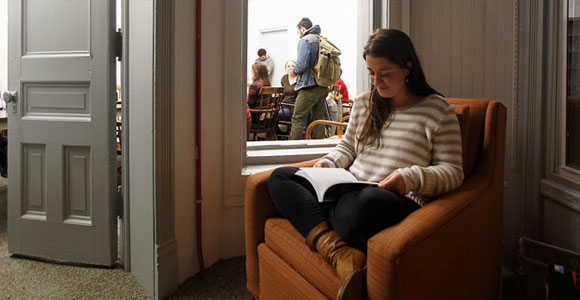
Art
Domestic writing
A quirky old house becomes Creative Writing’s new home.
Carrie Golus, AB’91, AM’93
In September—as painters, filmmakers, musicians, and actors settled into the sleek new Logan Center for the Arts—the Committee on Creative Writing unpacked its boxes in Taft House, a three-story red-brick Victorian pile half a block away.
Previously, Creative Writing was dispersed around campus: the full-time lecturers had offices in Gates-Blake, chair Janice Knight and coordinator Kate Soto were in Walker, and “the classes were just wherever,” Soto says. “It felt like a very large body of people, doing things separately.”
Now everyone who has anything to do with creative writing has an oddly shaped, dimly lit room of one’s own in Taft House. The first floor holds administrative offices, a conference room for classes and meetings, and a student lounge with a coffeepot; outside, a porch extends on two sides. The upper floors house faculty offices, the literary journal Chicago Review, and student journals such as Sliced Bread, Euphony, and 1000 Typewriters. Starting winter quarter, all Creative Writing classes will be taught in its two classrooms (one is next door in the adjoining Midway Studios) or at the Logan Center.
“Taft House really feels like a writer’s house,” says Knight. “It feels like a home.” Already, she says, proximity has made a difference. When classes end, students linger in the lounge, drinking coffee and talking about writing; instructors in their offices chat across the hall.
Over time, Knight hopes that informal mentorships will grow between the professionals at Chicago Review and the student journal editors.
The rambling old house is “perfect for creative writing,” says Soto. “There are a lot of little nooks where you can be alone, to read a book or write in your journal. But there are a lot of community spaces too, which are both pieces of the writer’s brain.” Even by the standard of neglected period buildings, Taft House is pretty strange. There’s a diagonal fireplace in the foyer, windows that look original but are cut off by the staircase, bays where just one or two people would fit comfortably. Poet John Wilkinson’s office includes a bumpout that might have been a bay window, except it lacks windows.
The provenance of the house is as mysterious as the building itself. During the opening party after the move, Paul Durica, AM’06, who teaches nonfiction writing and gives historical tours of Chicago, spoke about the history of the house and the adjoining Midway Studios—but mostly about the studios, which have been extensively documented. “Taft House is always sort of an afterthought, or appendage,” says Durica. “It doesn’t turn up in the historical record that much.”
Taft House is named for sculptor Lorado Taft (1860–1936), whose works include the Fountain of Time (1922) at the west end of the Midway Plaisance, as well as smaller portraits, such as the bust of Silas Cobb over the doors to Cobb Hall. Educated at the École des Beaux-Arts, Taft became head of the sculpture department at the School of the Art Institute, but at the University he held the vaguely defined, nontentured position of professorial lecturer on the history of art.
Midway Studios, where Taft worked and where many of his apprentices lived as well as worked, was originally located one block east. Taft wanted to foster a community of artists; it was a “Renaissance-style workshop,” says Durica, where Taft and his apprentices would eat together every day, sometimes joined by more established artists and writers.
In 1929, when the University needed the land to build Burton-Judson, Midway Studios moved west and was grafted on to Taft House. Taft never actually lived in the house; it presumably provided dormitory space for his apprentices.
Taft was also an author. He wrote two books, Modern Tendencies in Sculpture (1921) and The History of American Sculpture (1930), and “dabbled in literature a little bit,” says Durica. He was at the center of a Chicago arts movement that included Harriet Monroe, who founded Poetry in 1912, and novelist Hamlin Garland, who married Taft’s sister.
“It’s oddly appropriate that Creative Writing is here, given all the writers and poets who circulated through. In a very tactile way, it connects Chicago’s literary past to its present,” says Durica. If anyone in Creative Writing was disappointed about not getting space in Logan, “once we saw the house, that sadness dissipated.”
